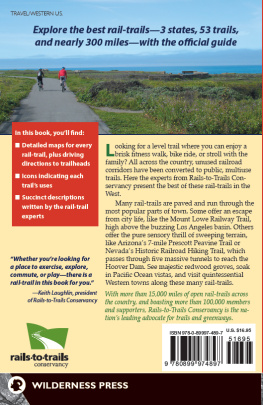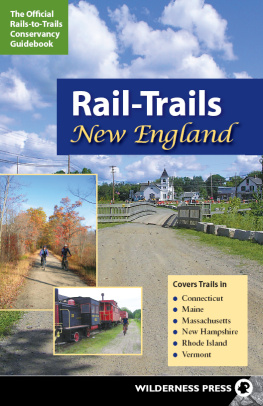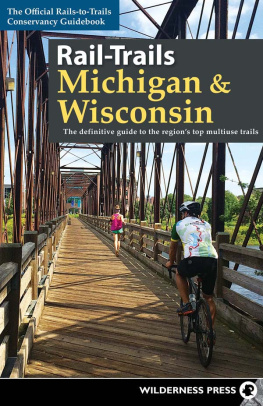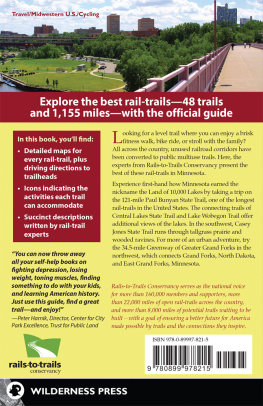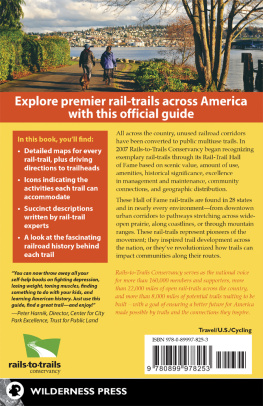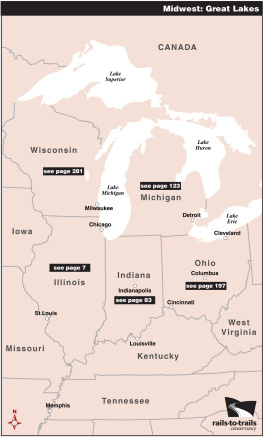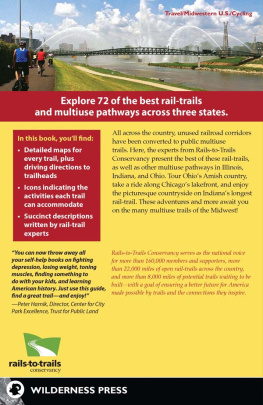

Rail-Trails: West
1st EDITION 2009
Copyright 2009 by Rails-to-Trails Conservancy
Front cover photographs copyright 2011 by Rails-to-Trails Conservancy
Cover photographs copyright 2009 by Bryce Hall (main and inset right) and Rails-to-Trails Conservancy (inset left and back cover) All interior photographs by Rails-to-Trails Conservancy, Boyd Loving, Darrin Gardiner.
Maps: Tim Rosner and Lohnes+Wright
Cover design: Lisa Pletka
Book design and layout: Lisa Pletka and Larry B. Van Dyke
Book editors: Laura Shauger, Jennifer Kaleba and Wendy Jordan
ISBN 978-0-89997-489-7
Manufactured in the United States of America
| Published by: | Wilderness Press |
| 1345 8th Street |
| Berkeley, CA 94710 |
| (800) 443-7227; FAX (510) 558-1696 |
| info@wildernesspress.com |
| www.wildernesspress.com |
Visit our website for a complete listing of our books and for ordering information.
| Cover photos: | Monterey Peninsula Recreational Trail (main) ; Martin Luther King Promenade (inset top) ; Lands End Trail (inset bottom) ; Half Moon Bay Coastside Trail (back cover) |
| Title page photo: | Delta Meadows River Park |
All rights reserved. No part of this book may be reproduced in any form, or by any means electronic, mechanical, recording, or otherwise, without written permission from the publisher, except for brief quotations used in reviews.
SAFETY NOTICE: Although Wilderness Press and Rails-to-Trails Conservancy have made every attempt to ensure that the information in this book is accurate at press time, they are not responsible for any loss, damage, injury, or inconvenience that may occur to anyone while using this book. You are responsible for your own safety and health while in the wilderness. The fact that a trail is described in this book does not mean that it will be safe for you. Be aware that trail conditions can change from day to day. Always check local conditions, know your own limitations, and consult a map.
About Rails-to-Trails Conservancy
Headquartered in Washington, D.C., Rails-to-Trails Conservancy (RTC) fosters one great mission: to protect Americas irreplaceable rail corridors by transforming them into multiuse trails. Its hope is that these pathways will reconnect Americans with their neighbors, communities, nature, and proud history.
Railways helped build America. Spanning from coast to coast, these ribbons of steel linked people, communities, and enterprises, spurring commerce and forging a single nation that bridges a continent. But in recent decades, many of these routes have fallen into disuse, severing communal ties that helped bind Americans together.
When RTC opened its doors in 1986, the rail-trail movement was in its infancy. While there were some 250 miles of open rail-trails in the United States, most projects focused on single, linear routes in rural areas, created for recreation and conservation. RTC sought broader protection for the unused corridors, incorporating rural, suburban, and urban routes.
Year after year, RTCs efforts to protect and align public funding with trail building created an environment that allowed trail advocates in communities all across the country to initiate trail projects. These ever-growing ranks of trail professionals, volunteers, and RTC supporters have built momentum for the national rail-trails movement. As the number of supporters multiplied, so too did the rail-trails. By the turn of the 21st century, there were some 1100 rail-trails on the ground, and RTC recorded nearly 84,000 supporters, from business leaders and politicians to environmentalists and healthy-living advocates.
Americans now enjoy more than 15,000 miles of open rail-trails. And as they flock to the trails to commune with neighbors, neighborhoods, and nature, their economic, physical, and environmental wellness continue to flourish.
In 2006, Rails-to-Trails Conservancy celebrated 20 years of creating, protecting, serving, and connecting rail-trails. Boasting more than 100,000 members and supporters, RTC is the nations leading advocate for trails and greenways.
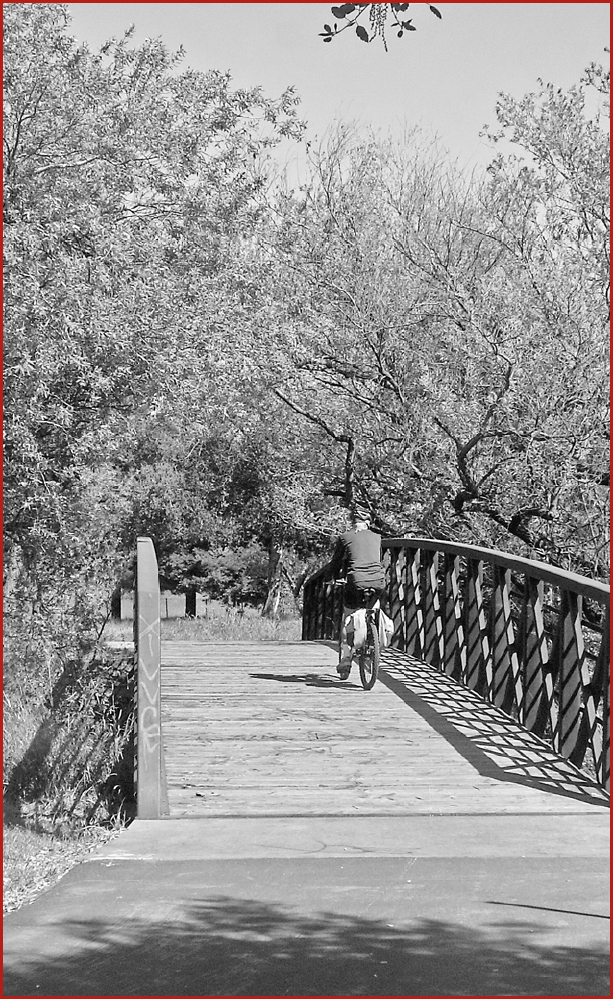
People use Californias 4.4-mile Fairfield Linear Park to access Solano Community College Campus and the Fairfield city center.
Foreword
Dear Reader:
For those of you who have already experienced the sheer enjoyment and freedom of riding on a rail-trail, welcome back! Youll find Rail-Trails: West to be a useful and fun guide to your favorite trails, as well as an introduction to pathways you have yet to travel.
For readers who are discovering, for the first time, the adventures you can have on a rail-trail, thank you for joining the rail-trail movement. Since 1986, Rails-to-Trails Conservancy has been the No. 1 supporter and defender of these priceless public corridors. We are excited to bring you Rail-Trails: West so you, too, can enjoy this regions rail-trails.
Built on unused, former railroad corridors, these hiking and biking trails are an ideal way to connect with your community, with nature, and with your friends and family. Ive found that rail-trails have a way of bringing people together, and as youll see from this book, there are opportunities in every state you visit to get on a trail. Whether youre looking for a place to exercise, explore, commute, or playthere is a rail-trail in this book for you.
So I invite you to sit back, relax, pick a trail that piques your interestand then get out, get active, and have some fun. Ill be out on the trails, too, so be sure to wave as you go by.
Happy Trails,
Keith Laughlin
President, Rails-to-Trails Conservancy

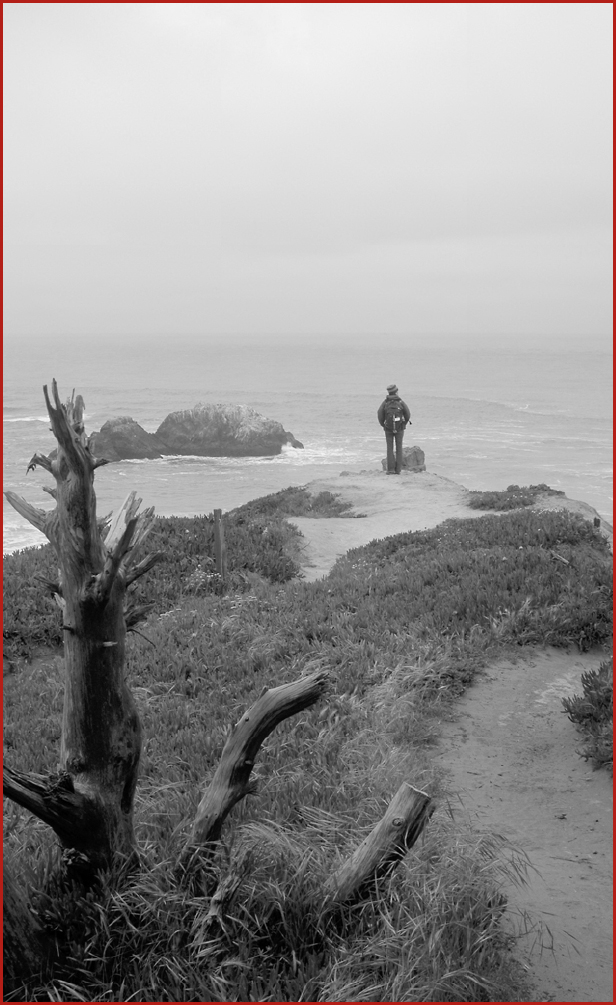
Fogged in or clear as a bell, the view from the peak of San Franciscos Lands End Trail is an unforgettable and unique rail-trail experience.
INTRODUCTION
O f the roughly 1,400 rail-trails across the U.S., Rail-Trails: West highlights 53 in Arizona, California and Nevada. These rail-trails tread storied routes of westward expansion and industrialization. They bear the signatures of their history, left behind in tunnels and trestles, raised berms and depots, communities born and abandoned.
Some of the original railroads in western states bridged vast stretches of forbidding desert and tied distant states together. Others fed gold mines and gold rushes, or served as logging lines through the pine canyons of northern California. Dozens more retrace the tracks of passenger and freight lines up and down the Pacific coast. Their original purposes and destinations vary, but each of these rail-trails joins past with present, creating a living memorial of the corridors that helped shape the West.
Many of Arizonas rail-trails showcase a sweeping desert landscape of sunbaked prairies and wind-worn mountains. Among the states standout trails are the Peavine and Iron King in Prescott, where wildflowers cling to crevasses in boulders the size of buildings. Offering an even more rustic desert adventure, the Mohave and Milltown Railroad Trail follows a line that connected a gold mine with the Colorado River in 1903.

